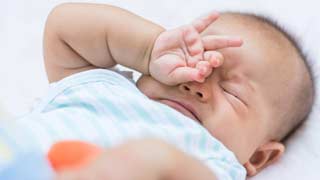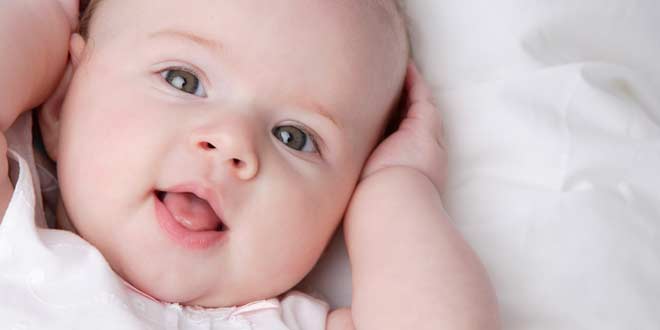If you see one or more of the following signs, take your child to your child’s health care provider as soon as possible. Talk about the need for your child to see an eye doctor–if possible, an eye doctor who is trained and has experience working with young children.
What do your child’s eyes look like?
A pupil (the circle in the middle of the eye that is traditionally black in appearance), appears to be white in one or both of your child’s eyes. Look closely at photographs of your baby. If the red glow is not the same in both eyes or is white or yellow in one eye, this may indicate a vision problem. Show photographs to your child’s health care provider.
Eyes don’t line up or don’t move together (one eye appears to turn in, out, up, or down) at any age, and especially after age 4 months. If your baby’s eyes constantly seem to look in different directions, visit an eye doctor right away
Eyelids are red-rimmed, crusted, or swollen for more than 24 hours.
Eyes are watery or red with tears running down the cheeks when your child is not crying.
One or both eyelids droop, nearly covering the colored part of the eye (iris).
One pupil looks larger than the other pupil.
Eyes seem to bounce, dance, shake, or wobble.
One or both eyes look cloudy.
When should you take your child to an eye doctor?
If you see any of the signs and symptoms above, visit your child’s health care provider to talk about a referral to an eye doctor (pediatric ophthalmologist or pediatric optometrist). The referral should go to an eye doctor trained and experienced with working with infants and young children.
Most vision problems can be corrected if they are detected and treated early. Appropriate eye care is important to help your child have the best vision possible to learn and develop.
Some vision problems, if left untreated – even for a short amount of time – can result in permanent vision loss. Do not take a “wait and see” approach to vision problems in children!
Newborn infants should have his or her eyes checked while still in the hospital nursery. During every regular well-baby health visit, from birth to age 6 years, your child’s health care provider should use family history and special tests to check for vision and eye problems. Beginning at age 12 months, vision screenings may include instruments that look like cameras.
Are some children more likely to have vision problems than other children?
 How does your child act?
How does your child act?
Rubs eyes often.
Closes or covers one eye when looking at a book or toy.
Always tilts head to one side, especially when playing with toys, or pushes head forward or backward in an effort to see objects better.
Blinks eyes more than usual or more than other children.
Frequently squints, as if trying to focus on an object.
Seems clumsy or frequently bumps into objects.
Holds books or toys close to eyes.
Avoids looking at people or objects that are held close (within 8 to 15 inches; 20.32 to 38.1 cm) to the face.
Yes. Your child’s health care provider should be aware of the following health history that may make your child more likely to develop a vision problem:
Your child was born prematurely (less than 32 weeks completed gestation.)
You, or an immediate family member, have a family history of vision disorders, such as childhood cataract, amblyopia (may also be called lazy eye), misaligned eyes, eye tumors, or wore glasses before first grade.
Your child had an eye injury (problems resulting from childhood eye injuries may develop much later in life.)
Your child has been diagnosed with a problem that could affect his or her physical, mental and/or, emotional development.
If your child has any of these factors, visit your child’s health care providerand talk about the need for a referral to an pediatric ophthalmologist or pediatric optometrist
How would your child’s vision disorder be treated if treatment is required?
Your child may have to wear glasses to help him or her see up close or far away. Specially designed eyeglass frames for small children, including babies, are available.
Medication, such as eye drops or ointments, may be used to treat infections and other eye conditions, including allergies.
Eyeglasses may be prescribed to correct a crossed or misaligned eye (also called strabismus.)
One eye may be patched or eye drops may be used in one eye to help strengthen the other eye, which is common in the treatment of amblyopia (lazy eye.)
Surgery may be needed to remove a lens with a cataract or to reduce pressure inside the eye for glaucoma. Surgery can also correct a crossed or misaligned eye.
Eye exercises may be used to help the eyes work together better.
Many infants have a problem with his or her tear ducts and require treatment if the problem lasts after more than a few months of age.
Being aware of your baby’s overall health and development will help you to know if there is a medical need.
Source: iowa


